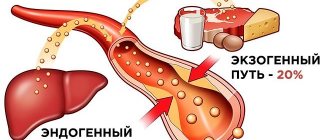We often notice beer drinkers have a rounded tummy, which becomes the object of jokes and jokes. In fact, there is nothing funny about this; cholesterol, a huge amount of which is found in beer, contributes to the clogging of blood vessels and leads to obesity. Beer and cholesterol are incomparable things, this needs to be remembered, especially for people with a hereditary predisposition to vascular diseases and diabetes.
Among poorly informed people, there is an opinion that beer dilates blood vessels and increases the pressure in them, helping to flush out cholesterol plaques. This opinion applies to strong varieties of alcoholic drinks, such as vodka or cognac, and only if they are consumed at the rate of 1 g per 1 kg of body weight, once a week. Beer is a drink that cannot be drunk in small portions; calculations are made in liters.
The health benefits and harms of beer
Beer has a number of clearly positive aspects. Occasional consumption in small doses can strengthen vascular walls and generally improve the condition of the cardiovascular system (we will tell you more about the effect of a foamy drink on the heart a little later), prevents the formation of kidney stones, since it has diuretic properties, helps to lose weight, and reduces the threat of blood clots and can reduce high cholesterol when consumed correctly. There is also a beneficial effect of foam in diabetes mellitus - cell membranes become more susceptible to insulin, it is absorbed faster and more fully and thereby lowers sugar.
At the same time, with frequent and uncontrolled drinking , this intoxicating drink has a huge negative impact on the reproductive system of both men and women. It contains phytoestrogen , which disrupts the balance of male and female sex hormones. In the strong half of humanity, it increases the synthesis of the hormone estrogen, which leads to a restructuring of the body according to the female type, which will manifest itself both internally and externally. Abuse increases the risk of circulatory system disorders - heart attacks and strokes, bleeding, atherosclerosis. Added to all this is the classic toxic effect of alcohol on the body.
How does beer affect blood cholesterol? It has been proven that the hop product does not contain a fatty component . As a result, it also does not contain cholesterol. But this drink contains compounds and substances that can help stabilize cholesterol balance in the event of an increase in harmful lipids. This effect is due to beer due to phytoestrogen, which in small concentrations slightly inhibits the level of testosterone synthesis, thereby reducing the load and blood pressure on the blood vessels. In addition to phytoestrogen, hypocholesterolemic substances in beer include :
- Kholin . In the body, it is responsible for the functioning of cellular receptors for LDL (low-density lipoproteins - a type of the same bad cholesterol that can lead to atherosclerosis), thereby accelerating the removal of cholesterol from the bloodstream.
- A nicotinic acid . Unlike choline, it directly affects cholesterol itself, regulating its concentration in the blood, also prevents hypertriglyceridemia and has a positive effect on the body both during the course of diabetes mellitus and during its development.
- Magnesium . This is one of the elements that accelerates the removal of harmful cholesterol by bile.
- Selenium . It has a stimulating effect on the synthesis of beneficial cholesterol - HDL (high-density lipoproteins - they are not able to stick to the walls of blood vessels and form atherosclerotic plaques, and as a result, do not harm the body).
- Vitamins . With hypovitaminosis of Folic acid and Pyridoxine, the risk of diseases of the vascular system increases. Thanks to their content in the foamy drink, such hypovitaminosis can be prevented.
A little bit of history
Beer is one of the oldest drinks, as evidenced by archaeological research.
Thousands of years ago, people prepared a drink from cereals, which in terms of preparation technology is very close to beer. The ancient Sumerians had more than 15 varieties of this drink and the saying “not knowing beer is not knowing joy.” The ancient Egyptians, having borrowed the secrets of brewing from the Sumerians, also joined the army of fans of the foamy drink. The process of making beer is immortalized in relief images on Egyptian tombs. In Egypt, beer was a very popular and even democratic drink - everyone drank it, both peasants and nobles. The drink was valued for its taste and properties to quench thirst and improve tone.
From Egypt, beer spread to Ethiopia, then to Persia, and beyond. In Europe, beer, already very close to modern beer, began to be brewed in the 13th century.
Beer is an ancient drink. Archaeologists have proven that thousands of years ago the drink was prepared using hops and grains. It was close to modern beer. The Sumerians alone had about 15 recipes that they invented. The Egyptians borrowed it from them. Frescoes depicting its brewing and consumption have survived to this day. Then it spread to Persia and Ethiopia.
In ancient Rus', beer was brewed from honey and cereals. Peter I put brewing on an industrial basis. Factories appeared in the 17th and 18th centuries. At first, brewers were invited from abroad for this purpose.
Beer is a low-alcohol drink. To prepare a natural drink, malt, barley wort, and hops are used. The fermentation process is carried out by adding yeast.
Is it possible to drink beer if you have high cholesterol?
As you can see, you can drink beer if you have high cholesterol , since it does not contain any fats. It contains a number of chemical compounds, trace elements and substances that have a positive effect on cholesterol balance. Studies conducted by a number of scientists from Spain were designed to prove or disprove this effect of the drink on cholesterol in practice. A number of volunteers with high cholesterol consumed 1 bottle of beer daily. As a result, at the end of the experiment, in 38% of patients, the lipid ratio and their levels returned to normal.
It must be remembered that only moderate doses of this low-alcohol drink are beneficial for the body. With excessive consumption, as with any other abuse of alcohol, beer becomes an enemy of our body and can lead to alcoholism. In the context of today's topic, this leads to a faster onset of atherosclerosis. How much beer should you drink to avoid such consequences and to improve the health of our internal systems?
Nutritional value of foamy drink
What does the body receive after drinking 1 bottle (0.5 l) of beer:
- 12-32 g of ethyl alcohol (with a drink strength of 3 to 8% vol.), which corresponds to 38-80 ml of vodka;
- 17.8 g carbohydrates, 2.3 g protein (215 kcal);
- B vitamins (10.1% of the daily requirement for B vitamins). 4, 7% B2, 11.5% B6, 7.5% B9 (folic acid), 12.8% B3 or PP).
- A number of trace elements: 5.4% potassium, 7.5% magnesium, 8.8% phosphorus, 5.5% fluorine and selenium.
Beer does not contain cholesterol, as it is a product of plant processing.
Effect on the heart
Hypertension, shortness of breath during low exertion, various cardiac dysfunctions - each of these signs can be a symptom of lipid imbalance. Beer in small quantities has a beneficial healing effect on many diseases of the cardiovascular system. Against the background of the influence of cholesterol, the blood becomes more viscous and flows more slowly through the vessels, and beer helps thin the blood, thus improving blood flow; reduces the risk of thrombosis and the formation of cholesterol plaques in the walls of blood vessels.
Beer contains antioxidants that slow down intracellular aging processes, including heart muscle cells. In addition, our foamy drink tones and improves blood circulation, maintaining the stability of its functioning.
Reasonable approach
Among doctors, such a concept as “standard dose of alcohol” is applicable. This is a certain amount of drink that contains 10 g of pure ethanol (absolute alcohol). A standard dose of beer, which contains this volume of alcohol, fits into 250 ml of foam.
What dose of alcohol is considered safe?
That is, without causing harm, you can consume daily:
- women: 750 ml foam;
- for men: one liter of intoxicating drink.
There is a recommendation on how many times a week you can drink beer. A dose of intoxicating drink consumed no more than 4-5 times weekly is considered safe. But at the same time, the annual norm of beer should not exceed 800 standard servings. This means that you can drink the following per week without harm to your health:
- women: up to 3,750 ml;
- men: up to 5 liters.
WHO experts also indicate doses of foam that become hazardous to health. This is 4.8 standard doses for women and 6.4 standard doses for men. If we convert this into liters, then the dangerous beer portion will be as follows:
- women: from 1.2 l;
- men: more than 1.6 l.
Of course, each person has the right to control the amount of foam he drinks. But, if your own health is more expensive, you should avoid excess amounts and adhere to the permitted consumption standards.
High risk groups
All conclusions of the Health Organization specialists are averaged. Here you should take into account a number of additional, individual factors, which include health status, body weight, the presence of chronic diseases and much more. For some individuals, even one standard and permitted daily dose of beer will become harmful.
There is a hereditary predisposition to alcohol, in which it is not recommended to consume any alcohol
The group that is at increased risk includes the following categories of citizens:
- Pregnant women. The foamy drink will be eliminated from the body of the expectant mother in about 1.5-2 hours. And all this time, ethanol will begin to have a detrimental effect on the developing fetus.
- Former alcohol addicts. Alcoholism, even cured, leaves its mark on the body forever. Therefore, former alcohol addicts will have to give up consuming any, even low-alcohol, alcohol throughout their lives.
- Persons with congenital resistance to ethanol. Such people should especially monitor alcohol limits. These individuals can drink a lot without getting drunk and are most prone to developing alcoholism.
- Having medical contraindications. It is forbidden to consume any alcohol, even foam, if there are a number of existing pathologies, increased anxiety, mental disorders and some other diseases.
- Drivers. Even a slight intake of alcohol greatly reduces the level of concentration, which can lead to the creation of an emergency situation on the road.
- Elderly. With age, the human body weakens and becomes much more susceptible to alcohol. Therefore, doctors strongly recommend that people over 60 years of age limit themselves to one standard dose of beer per day.
- Young. Especially teenagers, it is extremely dangerous for them to drink alcohol, even in permitted doses. At this time, the body is rapidly developing, the hormonal system is changing and rearranging. Even a minimal dose of alcohol has an extremely negative impact on health and sometimes leads to irreversible and dangerous consequences.
Situations requiring special attention
There are a number of symptoms that indicate that a person has an excessive and dangerous addiction to intoxicating drinks. Moreover, even one warning sign makes you sound the alarm, as it shows the development of alcohol addiction. These are the following symptoms:
- a sharp drop in self-control while drinking;
- constantly exceeding the maximum permissible dose;
- sudden changes in human behavior after drinking beer;
- denial of the problem, even with all available factors and evidence;
- a constantly high level of anxiety due to certain circumstances that prevent you from indulging in your favorite drink.
What to do when these warning signs are present and a person is slowly embarking on a dangerous path of addiction? If you have the willpower and determination, you can overcome this addiction on your own, of course, with the full support of your relatives and family members.
If you cannot solve this problem on your own, you have to resort to the help of medical specialists. Modern pharmaceuticals have developed many drugs and methods that help people cope with the threat of alcoholism
It is important to notice the problem in time and not let it take its course.
Reviews and warnings
The attitude of medical specialists towards attempts to use beer to treat atherosclerosis and other cholesterol diseases is quite cautious. Not all patients who see a connection with alcohol as a cure for cholesterol will strictly adhere to the norms and its daily consumption. In this case, cholesterol may increase and worsen the course of the disease. But does beer raise cholesterol when drunk in moderation? Now that we have examined the entire mechanism of interaction between beer and cholesterol, we can assume that no .
Of course, it is impossible to eradicate this disease only with an intoxicating drink. However, by observing a moderate amount of a high-quality product, along with proper nutrition, a healthy lifestyle and the recommendations of doctors, we can alleviate the course of cholesterol disease and create the ground for further recovery.
Wine
Wines vary in strength and composition. The strength can vary from 9 to 25 degrees. Different varieties of grapes, fruits and berries are used to make wine. The resulting wine is white, red, rose, dry, semi-dry and sweet. Wine obtained from grapes contains many useful substances: antioxidants and vitamins. The largest amount of antioxidants is found in red wine.
Red wine can significantly improve blood composition, strengthen blood vessels and lower cholesterol levels.
Vodka
The components of forty-proof vodka are grain alcohol and water. To improve the taste of the drink, manufacturers add various components from plants: fruits, berries, oak bark, birch leaves, spices, flavorings. Small doses of vodka dilate blood vessels, increase blood circulation, and relieve symptoms of atherosclerosis. But you need to know that drinking vodka and cholesterol levels are directly related. Abuse of vodka will lead to high cholesterol and worsen human health. In addition, this drink can increase blood sugar.









